Garden Way of the Cross
Garden Way of the Cross
– Reprinted from information booklet and meditation-aid prepared by Father Thomas A. Stanley, S.M., Pastor of St. Catherine of Siena, Portage, Michigan in August 1993.
Father Stanley's Introduction and Historical Note
The Fourteen Stations of the Cross
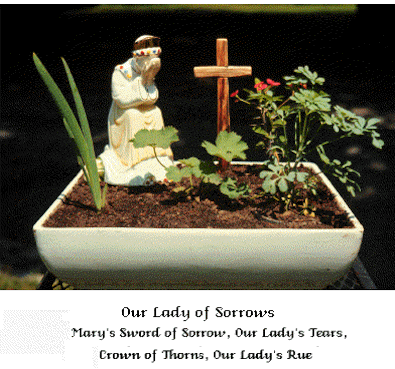
Introduction
A number of flowers with old religious names are accompanied by delightful legends woven around their symbolism. The legends served as vehicles by which their symbolism was passed on from parent to child, from generation to generation - as part of the teaching of religion before the days of printing and catechisms.
When the religious plant names were written down from oral traditions, however - most of them by folklorists and botanists, to whom we owe profound thanks for their preservation - many of the associated legends were lost. As one writer has observed, these missing legends are like petals which have been blown away from the flowers, which through pious reflection we are to attempt to rediscover and restore today.
One restoration of such legends, both as preserved and as recreated, is found in the booklet of flower meditations, "The Garden Way of the Cross," written in 1993 for the Mary Garden of St. Catherine of Siena Church, Portage, Michigan by Father Thomas A. Stanley, S.M., Pastor of St. Catherine's until 1996.
This meditative booklet was inspired by a large wooden cross at the west end of the Mary Garden (which extends along the entire south side of the church), installed there as a memorial of the 1983 Holy Year. In that year Pope John Paul II declared the privileges and graces available to those making Holy Year pilgrimages to Rome to be available also to those visiting their parish churches for the Holy Year intentions. As part of the celebration of this, St. Catherine of Siena Parish, in conjunction with the Edward L. Koenig Council No. 6980 of the Knights of Columbus, placed the outdoor cross where it stands today in the Mary Garden.
The presence of the cross recalls and continues the medieval custom of planting crosses in fields, for which the following blessing from the Roman Rite was employed:
Blessing of Crosses to be Set in Fields, Vineyards, etc.
(Performed on the Feast of the Finding of the Holy Cross, or on the following Sunday.)
V. Our help is in the name of the Lord.
R. Who has made heaven and earth.
V. The Lord be with you.
R. And with your spirit.
Let us pray.
Almighty, everlasting God, Father of all consolation and kindness, through the merits of the bitter passion of your only Son, our Lord Jesus Christ, which He was so kind as to undergo for us sinners on the wood of the cross, bless these crosses, which your people will take from here to set in gardens, vineyards, fields or other places, so that the farms on which they are set up may be free from the crushing of hail, the violence of tornadoes, the power of storms, and from every disturbance of the enemy. May then their produce by brought to full ripeness, and gathered in honor of your name by those who trust in the power of the holy cross of the same Jesus Christ, your Son, our Lord, who lives and is King with you for ever and ever.
R. Amen
(And they are sprinkled with holy water.)
One plant legend of special relevance to Christ's Cross is that of the herb, basil (Ocimum basilicum) which was held to be of such close association with the Cross that St. Helena was able to find the location of the True Cross by digging for it under a colony of basil plants. We know of the association through St. Helena, but just what the legend, the "fallen petal," was is not known to us. Possibly it was one of the plants which was reputed to have sprung up at the foot of the Cross where Christ's blood drops or Mary's tears fell, as is reported in legends of other plants. Or it may have been offered to Christ as a soothing herb. Another "fallen petal" is the use of "basilica" as the name for the cross-shaped floor plans of church buildings. Also, from the practice in some areas of strewing branches of basil before church communion rails it came to be known as "Holy Communion plant."
In composing "The Garden Way of the Cross" in 1993, Father Stanley drew on the religious flower names and legends which have been part of his reflection ever since he established the Mary Garden at the Our Lady of Lourdes Grotto at Dayton, Ohio, in 1954 - believed to be the first such Shrine Mary Garden in the U. S.
The flower symbols of Our Lady's Life and mysteries, and their interpretive legends, can be considered according to five groupings:
1. those of the virtues and excellences of Mary associated with her Immaculate Conception and maidenly spirituality;
2. those of the Joyful mysteries of the Annunciation, Visitation and the Sacred Nativity;
3. those of the life of the Holy Family in Nazareth;
4. those of the Sorrowful Mysteries of Jesus' Passion and Cross;
5. those of the Glorious Mysteries of Jesus' Resurrection and Ascension, the Descent of the Holy Spirit, and Mary's heavenly Assumption, Spiritual Maternity, Advocacy, Mediation and Queenship.
Father Stanley's illuminative incorporation of flower symbols and legends of the Sorrowful Mysteries in the fourteen stations of the Way of the Cross is instructive as how the other flower symbols and legends of Our Lady can be likewise incorporated in our meditations on the other mysteries of Mary's inimate motherly union and close cooperation with the saving work of her Divine Son and Lord.
It is to be kept in mind that flowers are encountered and their symbolism reflected on in nature, and also in the Mary Garden, one plant, grouping or colony at a time, while one pauses in meditation. This information booklet and meditation-aid is therefore to be used primarily as a source of information for subsequent reflection in nature or the garden (or indoors before dish gardens or house plants) - just as the Mary Garden Prayer is to be prayed before flowers, trees, shrubs and grasses.
In preparation for this it is suggested that in printing out this booklet from your web browser, supplementary printings be made of each flower graphic, so they can be viewed and reflected upon individually, in a virtual garden, after becoming familiar with their symbolism from the text. Also, the dish Mary Garden graphic at the head of this web page can be printed out separately and reflected upon, one flower symbol at a time, as would be done in an outdoor Mary Garden or an actual dish Mary Garden.
Father Stanley's Introduction and Historical Note:
The Mary Garden
The Mary Garden is a devotional shrine consisting of a presentation (usually a statue) of Mary, the mother of Jesus, set in the midst of a garden of special plants and flowers. Its purpose is to promote prayerful reflection on the ways of God, especially the plan he is following to bring about our salvation.
The custom of setting out a garden of flowers and plants connected in some way with the name and 1ife of the Blessed Virgin Mary began in medieval England. People of those times were especially keen in seeing signs and symbols of the presence of Jesus and his mother everywhere. Every fieldpath and hedgerow became an illuminated Book of Hours where some common flower, leaf or berry was assigned a holy association or lovely legend involving the Holy Family.
The practice of giving Marian names to flora of various kinds had its origin in the penchant of the Fathers of the Church for associating with the Blessed Virgin flowers and plants mentioned in Holy Scripture. This delightful mode of religious expression really balooned after the Crusades when tales told by returning uarriors sparked widespread interest in details of Holy Family life tied in with flora of the Holy Land.
Traditionally, all flowers are seen to be dedicated to the Mother of Jesus. Hence the great variety of them which fill the churches of Europe during her month - the month of May. Hence also the wreaths of flowers of all kinds and colors which the Flemish school painters delightedly used to encircle their paintings of the Mother and Child. But there are also many flowers with which Our Lady's name is, in one form or another, directly connected. Thus all plants and flowers are proper to a Mary Garden, but certain ones bearing her name (like Our Lady's Heart, Face, Gloves, Thimble, Keys, Slippers, Eyes, Bells, Tears, Mantle, etc.) are especially featured in Mary Gardens.
The first Mary Garden in the United States was begun in 1932 by Frances Crane Lillie at St. Joseph's Church in Woods Hole, Massachusetts. The idea began to spread soon after when two men (Edward A. G. McTague and John S. Stokes, Jr.) undertook the promotion of Mary Garden shrines out of a home office in Philadelphia, Pennsylvania. The Mary Garden at St. Catherine of Siena, probably the first in Michigan, seeks to continue this charming devotional practice.
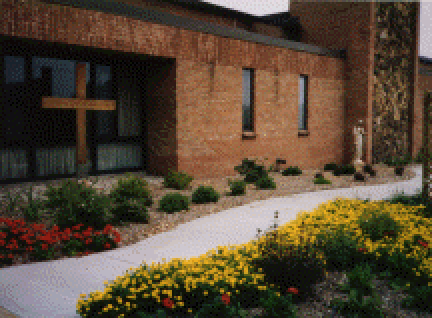
The Cross
The first Holy year in history was celebrated in 1300 with the idea that another Holy Year would be celebrated every 100 years thereafter. It did not take long to realize that 100 years was too long a wait and so the interval was first shortened to 50 years and then (as is the present arrangement) every 25 years. In modern times, Popes have also declared additional, special Holy Years. Pope Pius XI did this when he declared 1933 a speclal Holy Year marking the 1900th anniversary year of the death and resurrection of Jesus. Pope John Paul II followed this initiative and declared 1983 a special Holy Year to mark the 1950th anniversary year of our Redemption. Thus, in this century we have had four regular Holy Years (1900, 1925, 1950 and 1975) and two special ones (1933 and 1983).
The Holy Year is also a call for pilgrims to come to Rome. Those that do have special privileges and graces available to them. In 1983 Pope John Paul II broadened the celebration by declaring these same privileges and graces available to those visiting their parish churches to pray and mark the anniversary year. As part of its celebration, St. Catherine of Siena parish in conjunction with the Edward L. Koenig Council, No. 6980 of the Knights of Columbus placed the outdoor cross where it stands in the garden as a memorial of the 1983 Holy Year.
The Brick
Each of the four great basilicas in Rome (St. John Lateran, St. Peter, St. Mary Major and St. Paul) has a speciaI door to the right of its principal entrance. It is called the Holy Year Door because it is open only during a Holy Year. It is through this door that the holy year pilgrims are expected to enter and leave the basilicas.
In the years between the Holy Years, these doors, are walled up with special bricks and masonry. The bricks bear the coat of arms of the Pope in office at the time of the closing of the Holy Year together with an appropriate historical inscription. When the doors are broken open for the following Holy Year, the bricks are culled out, cleaned, numbered and made avaiiable to those who might request one for a special reason.
The brick embedded in the concrete at the foot of our wooden cross is such a brick. It was originally placed in the Noly Year Door of St. Peter's Basilica in 1975 and so bears the arms of Pope Paul VI. It also has the inscription; PAULOS PP. Vl PORTAM SANCTUM PATR. VATICANAE BASILICAE CLAUSIT ANNO JUBILAEI MCMLXXV (Pope Paul VI sealed the Holy Door of the Vatican Basilica ot the end of the 1975 Jubilee Year). It was removod in 1983 when Pope John Paul II ordered tbe door to be broken open to begin the special Holy Year he had decIared. With the help of a friend in Rome, Father Thomas A. Stanley obtained this brick as a Holy Year memorial for St. Catherine of Siena parish.
THE WAY OF THE CROSS
There is a tradition that the "sorrowful way devotion," also referred to as "the way of the cross," began almost immediately after Christ's death and resurrection when Jesus' mother, Mary, along with a group of Christ's disciples, would regularly retrace her Son's journey to Calvary stopping prayerfully at places of specia1 significance.
The Way of the Cross became a special devotion in Europe as the Crusaders began returning from service in the Holy Land. There, they too had walked prayerfully the path of Jesus to Calvary also stopping at key, Gospel-related sites. Back home sgain these veterans began to lay out "Little Jerusalems" where they could continue this devotional practice. As the devotion grew and religious imaginations became enthused, the number of stops or stations varied greatly, anywhere from 3 to 150. Gradually, the idea got recognition from the official Church. It was then permitted inside the churches and was standardized at 14 specific stations.
A number of these "official" fourteen stops have no basis in Scripture having had their origin in popular piety. As the 1975 Holy Year approached and devotional aids were being prepared in Rome for the expected influx of pilgrims, the Holy Father asked Father Argelo Bonetti to memorialize fourteen new stations or stages in Christ's passion, death and resurrection -- stages vhich were to be drawn from the Gospels and the prayers of the Church.
This meditation-aid, prepared for visitors to St. Catherine's Mary Garden, is based upon the fourteen stations proposed by Father Bonetti. In addition, each station is associated with a flower or flowers whose popular Mary-connection may prompt a devotiontal insight into that station's significance in the saving paschal mystery of the suffering, death and resurrection of Christ.
Extending the practice of meditating on the Stations of the Cross, the flower symbols of the Sorrowful Mysteries, planted around the garden cross, provide a mosaic of meanings for continuing meditation on the passion of our Lord and Savior, Jesus Christ.
The Fourteen Stations of the Cross
I. JESUS AT THE LAST SUPPER
When it grew dark Jesus reclined at table with the Twelve. In the course of the meal he said, "One of you is about to betray me." Judas, hls betrayer, spoke, "Surely it is not I, Rabbi?" Jesus answered, "It is you who have said it." During the meal Jesus took bread, blessed it, broke it, and gave it to his disciples. "Take this and eat it," he said. "this is my body." Then he took a cup, gave thanks, and gave it to them. "All of you must drink from it," he said, "for this is my blood, the blood of the covenant, to be poured out in behalf of many for the forgiveness of sins."
Consider the Maiden's Hair Fern (Adiantum capillis veneris) a Mary flower often used in England to decorate the altar for the feast of Corpus Christi which honors the Eucharist. Recall the woman who washed Christ's feet with her tears and wiped them with her hair; then ponder the example of Christ washing the feet of his disciples asking that they do as he did.
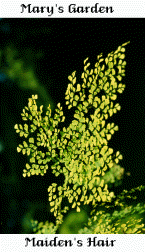
II. JESUS PRAYS IN THE GARDEN OF GETHSEMANI
Jesus made his way to the Mount of Olives. He withdrew from his disciples about a stone's throw, went down on his knees and prayed in these words: "Father, if it is your will, take this cup from me; yet not my will but yours be done." An angel then appeared to him from heaven to strengthen him. In his anguish he prayed with all the greater intensity, and his sweat became like drops of blood falling to the ground,
Consider the St. Johnswort (Hypericum perforatum), named "Christ's Sweat" from the blood-like red speckles dotting its yellow petals. Consider also the Wood Sorrel (Oxalis acetosella) a bitter Mary flower which, together with other bitter herbs, symbolizes the bitterness of our Lord's passion, and the depth of our Lady's sorrows. The triple leaf of this plant suggests the trinitarian scene in Gethsemani - (the Son praying to his Father and sustained by the Spirit in his agony). The sorrel's white flower stained with purple suggests the passion of the innocent victim, Christ.
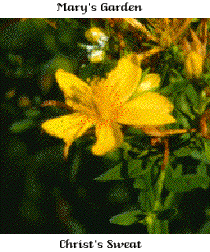
III. JESUS IS TAKEN PRISONER
While Jesus was still speaking, Judas, one of the Twelve, arrived accompanied by a great crowd with swords and clubs. They had been sent by the chief priests and elders of the people. His betrayer had arranged to give them a signal, saying, "The man I shall enbrace is the one; take hold of him." He immediately went over to Jesus and said to him, "Peace, Rabbi," and embraced him. Jesus answered, "Friend, do what you are here for." At that moment they stepped forward to lay hands on Jesus and arrested him.
Consider the Mistletoe (Viscum album). There is something very striking about the fresh golden-green leaves and white waxen berries of this plant as they spring from a tree in death-like winter sleep. It suggested to Marian devotees the Christ-flowering from the root of Jesse which took place in Mary's womb after an Old Testament winter of expectant waiting. It was formerly much used in church decoration. It is thought that the custom of kissing under the mistletoe originated in the ceremonia1 kiss of peaoe at the Christ Mass, a striking contrast to the kiss of Judas.
IV. JESUS 1S BROUGHT BEFORE THE SANHEDRIN
They led Jesus off to the chief priests. After a time the high priest rose to his feet and began to interrogate Jesus: "Have you no answer to what these men testify against you?" But Jesus renmained silent. Once again the high priest interrogated him: "Are you the Messiah, the Son of the Blessed One?" Then Jesus answered, "I am; and you wiil see the Son of Man seated at the right hand of the Power and coming with the clouds of heaven." At that the high priest tore his robes and said, "What further need have we of witnesses? You have heard the blasphemy. What is your verdict?" They all concurred in the verdict: gui1ty with its sentence of death.
Consider the iris or Mary's Sword of Sorrow (Iris sp.), from its sword- like foliage recalling the prophecy of Simeon to Mary at Presentation of the child Jesus in the Temple that he would be s sign that would be contradicted and Mary's own soul would be pierced with a sword, "that the thoughts of many hearts will be revealed." Consider also the lungwort (Pulmonaria officinalis), also known as The Virgin Mary's Tears or Our Lady's Milk Herb. The leaves of this Mary-plant are handsomely blotched and speckled with white. When it blossoms, pink buds open into blue flowers. It is said that Mary on her way out of Jeruselem after presenting Jesus in the Temple sat down to nurse him. This plant at her feet caught the blue of her eye, but they grew pink when Mary's eyes reddened with weeping as she reflected on the sufferings predicted for her Son. The baby moved suddenly and some of her milk fell on the leaves causing the white markings still on them.
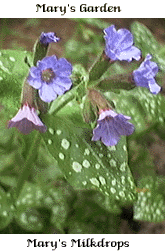
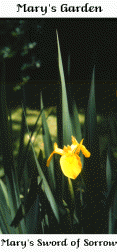
V. JESUS IS DENIED BY PETER
While Peter was down in the courtyard one of the servant girls said, "You were with Jeus of Nazareth." But he denied it. At that moment a rooster crowed. Again the servant said, "This man is one of them." Once again he denied it. Later the bystanders said to Peter, "You are one of them. You are Galilean, are you not? Peter cursed and said, "I don't even know the man." Just then a second cockcrow was heard.
Consider the Passion Flower (Passiflora sp.), whose ten petals were seen to symbolize the twelve apostles, less Judas who betrayed and Peter who denied.
On the other hand, consider the Cowslip (Primula veris) called Our Lady's Keys because the flowers suggest a bunch of keys by their pendant bloom clusters - the keys of Mary Mediatrix to the storehouses of heavenly grace. From its shape this flower is also dedicated to St. Peter, who, in spite of his denial of Christ, was eventually given the keys of the kingdom of heaven.
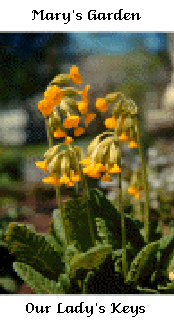
Consider also the Pansy (Viola tricolor) a name which comes from the French pensŽe (meaning thoughts), and from its three colors also known as Trinity Flower. It is dedicated to Mary who "kept all these things in her heart." So also did Peter and it led him to repentance.
VI. JESUS IS TAKEN TO PILATE
At daybreak they brought Jesus to the praetorium. There Pilate asked Jesus, "Are you the King of the Jews?" Jesus answered, "Are you saying this on your own, or have others been telling you about me?" "I am no Jew" Pilate retorted. "It is your own people and the chief priests who have handed you over to me. What have you done?" Jesus answered, "My kingdom does not belong to this world. If my kingdom were of this world, my subiects would be fighting to save me from being handed over to the Jews. As it is, my kingdom is not here."
Consider the Sundew (Drossera rotundifolia). This plant has a rosette of green leaves thickly covered with red hairs and on the tip of sach hair is a drop of dew. It is also called Gideon's Fleece which is a symbol of the Incarnation achieved in Mary's womb. This sign (a fleece dampened by dew while the ground all around was dry) was an answer to a prayer. Pilate too seeks a sign but does not recognize the one God gives him. Mary always recognized God's signs.
VII. JESUS 1S SCOURGED AND CROWNED WITH THORNS
Pilate had Jesus scourged and then handed him over to be crucified. The soldiers led Jesus away and dressed him in royal purple. Then they wove a crown of thorns and put it on him and began to salute him: "All hail! King of the Jews!" Continually striking Jesus on the head with a reed and spitting at him, they genuflected before him and pretended to pay him homage.
Consider Millfoil or Our Lord's Back (Achillea millefolia) whose myriads of red flowerets were seen to symbolize the welts of Christ's scourged back.
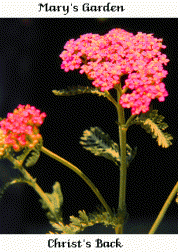
Also, the Crown of Thorns or Christ's Crown (Euphorbia splendens), whose intense tiny red flowers brought to mind the blood drops emerging from Christ's forehead at the thorn- pricks.
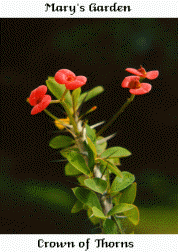
Then consider Our Lady's Seal or Black Bryony (Tamus communis). The root stock of this plant has great efficacy when crushed and spread in a medicinal plaster and applied to seal up a scar or bruise. It is known to be helpful in healing wounds, even in mending broken bones. How Mary must have wished to apply such a seal to the wounds of her Son.
VIII. JESUS IS CONDEMNED TO DEATH
When Jesus was accused, he made no reply. Pilate said, "Surely you hear how many charges they bring against you. He did not reply on a single count. Now on the occusion of a festival the procurator was accustomed to release one prisoner whom the crowd would designate. It was Barabbas, not Jesus, they chose. Pilate released Jesus to them to be crucified.
Consider the Lily of the Valley (Convallaria majalis) also called Our Lady's Tears. This flower is said to have had its origin at the moment of the condemnation of Christ to death for it was then that Mary wept and as her tears touched the earth, these flowers sprang up. The same legend is also associated with the Greater Stitchwort (Stellaria holostea) which also bears the name Tears of Mary.
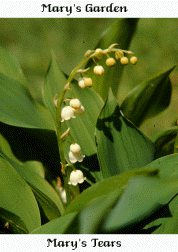
IX. JESUS WITH SIMON OF CYRENE MEETS WOMEN OF JERUSALEM
As they led him away, they laid hoId of Simon of Cyrene who was coming in from the fields. They put the cross beam on his shoulders to carry along behind Jesus. A great crowd followed including women who beat their breasts and lamented over him. Jesus said to them, "Daughters of Jerusalem, do not weep for me. Weep for yourselves and your children. The days are coming when they will say to the mountains, 'Fall on us' and to the hills, 'Cover us.' If they do these things in the green wood, what will happen in the dry?"
Consider the Ground Ivy (Nepeta glechoma) which is also called Where-God-Has-Walked and Madonna's Herb. There are bright splashes of color wherever it grows in large patches along oountry hedges and on waste ground. It's leaves are heart shaped and its shoots, both stem and leaf, are of various shades of red and purple. Its labiate flowers, which grow out of the stem, are usually purple but also sometimes white. A lovely reminder that God did walk this earth even to Calvary where he died for us.
Consider the Tiger Flower or Christ's Knee (Tigridia pavonia), symbol of Christ's bloodied knees from his falls while carrying the Cross.
X. JESUS IS CRUCIFIED
They brought Jesus to the site Golgotha aod crucified him. It was about nine in the morning. The inscription proclaming his offense read: "The King of the Jews." With him they crucified two insurgents. People going by kept insulting him, saying, "Ha, ha! So you were going to destroy the Temple and rebuild it in three days! Save yourself now by coming down from that cross!" The chief priests and the scribes also joined in and jeered. The men crucified with him likewlse kept taunting him.
Consider the Violet (Viola odorata) also called Our Lady's Modesty or Humility. It is said to be among the flowers of which the shadow of the cross fell on the day of the crucifixion. It dropped its head in sorrow and in acknowledgement of the import of this great event and has always remained thus. Its color suggests the purple of the Church in mourning.
Consider also Ladies' Tresses (Spiranthes cernua), known formerly as Our Lady's Tresses. It takes this name from the spiral of its flower heads reminiscent of plaited hair and is associated with the legend that Mary at the foot of the cross and in deep agony tore out a tress of her hair which St. John thereafter preserved.
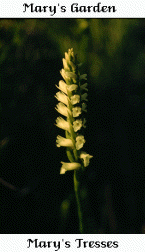
XI. JESUS DIES ON THE CROSS
Jesus said, "Father, forgive them; they do not know what they are doing." Near the cross of Jesus there stood his mother, his mother's sister, Mary the wife of Clepas, and Mary Magdalene. Seeing his mother there with the disciple whom he loved, Jesus said to his mother, "Woman, there is your son." In turn he said to the disciple, "There is your mother." From that hour onward, the disciple took her into his care. Toward midafternoon Jesus cried out in a loud tone, "My God, my God, why have you forsaken me?" Then he said, "Father, into your hands I commend my spirit." He bowed his head and delivered over his spirit.
Consider the red poppy together with the white flowers of Christ's Blood Gromwell or Mary's Drops (Papaver Tears (Lithospermum oriental) whose red officinalis) mingled with them flowers were said to have as wellsprings of the outpouring of sprung up at the foot of Christ's grace mediated to the the cross from Jesus' the world through Mary's sorrowful redemptive blood drops. motherly heart.
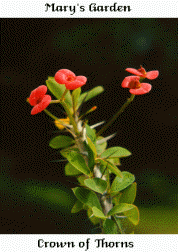
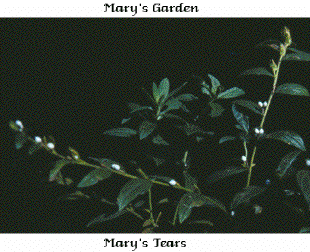
Consider the Snowdrop (Galanthus nivalus). It is said that when our first parents were banished from Eden they found winter beyond its gates. Eve stood sobbing, broken-hearted. The leafless trees, the bare ground and the biting winds were a dreadful contrast to the bowers of the garden of pleasure. God sent an angel to comfort her. The angel pointed to the ground where her tears of penitence had fallen and lo! there sprang up a little plant with a teardrop for its blossom. He gave the blossom to Eve, telling her that it was an assurance that happiness would return to her and all her progeny. The death and resurrection of Christ fulfills the promise of the Snowdrop.
XII. JESUS' SIDE IS PIERCED BY A LANCE
The Jews asked Pilate that the legs of the crucified be broken and the bodies taken away. Wben they came to Jesus and saw that he was already dead, they did not break his legs. Instead, one of the soldiers thrust a lance into his side and immediately blood and water flowed out. These events took place for the fulfillment of the Scripture: "Break none of his bones." There is another Scripture passage which says: "They shall look on him whom they have pierced."
Consider the Bleeding Heart (Dicentra spectabilis) - long associated with the suffering hearts of Jesus and Mary - and thus known both as Christ's Heart, and also Mary's Heart; each of whose pendant heart- shaped blooms has at its base a red and white droplet, signifying the mixture of blood and water flowing from Christ's pierced side.
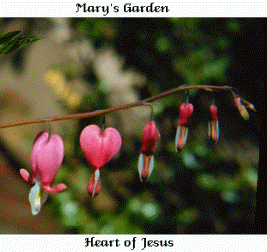
Consider also the tradition which tells us that the Bracken (Pteridium aquilinus) was among the hay in the manger at Bethlehem, but refused to acknowledge the presence of its Creator and so thenceforward it lost the flowers it once bore. But the bracken repented. Now when Christmas draws near, its dry stems when cut open bear a symbol of its sorrow: either the figure of our first parents in Eden, one on either eide of the fateful tree, or else the sacred monogram of our Redeemer: IHS (meaning "Jesus, Savior of Humankind"). From this mark of loving penitence it is also called Fern of God.
XIlI. JESUS IS BURIED
There was a man named Joseph, from Arimathea, and he looked expectantly for the reign of God. He approached Pilate with a request for Jesus' body. He took it down, wrapped it in fine linen, and laid it in a tomb hewn out of the rock, in which no one had yet been buried. The women wbo had come wlth him from Galilee followed along behind. They saw the tomb and how his hody was buried. Then they went home to prepare spices and perfumes.
Consider the Rosemary (Rosmarinus). Legend says that it has been aromatic and evergreen since the time the swaddling clothes of the Holy Infant were hung upon it, and that since his death, it has borne purple markings upon its lavender flowerets in memory of Calvary. In olden times it was customary to strew rosemary on the tombs of the departed.
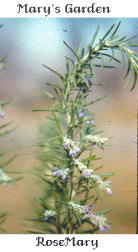
XIV. JESUS RISES FROM THE DEAD
After the sabbath, as the first day of the week was dawning, Mary Magdalene came with the other Mary to inspect the tomb. Suddenly there was a mighty earthquake as the angel of the Lord descended from heaven. He came to the stone, rolled it back, and sat on it. In appearance he resembled a flash of lightning while his garments were as white as snow. The guards grew paralyzed with fear of him and fell down 1ike dead men. Then the angel spoke, addressing the women: "Do not be frightened. I know you are looking for Jesus the crucified, but he is not here. He has been raised exactly as he promised."
Consider the Tansey (Tanacetum vulgare). Its hard golden flowerets will keep their color for a long time if dried when they are at their best. Perhaps it is from this everlasting quality that it gets its name tansy for it is a word derived from athanatos (the Greek word for immortality). Its health giving properties may also have inspired ite name. In Europe it is called Jesus-wort. Consider a1so the Rose of Jericho or Resurrection Plant (Anastatica hierochuntica) which was brought to Europe from the Holy Land by the Crusaders. After flowering it dries up, but when soaked in water, opens up again.
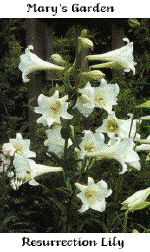
Today the Easter Lily is widely valued as a symbol of Christ's Resurrection.
Conclusion
For a smaller garden a Passion Flower vine (Passiflora Incarnata) may be trained to climb up at the base of the cross, presenting its multiple symbolism of:
The spiraled tendrils - the Lash of Christ's Scourging
The central flower column - the pillar of the Scourging
The 72 radial filaments - the Crown of Thorns
The top 3 stigma - the 3 Nails
The lower 5 anthers - the 5 wounds
The Style - the Sponge used to moisten Christ's Lips with Vinegar
The leaves (some species) - the head of the Centaurian's Spear
The red stains - Christ's Blood Drops
The Round Fruit - The World Christ came to save
The Fragrance - The Spices prepared by the Holy Women
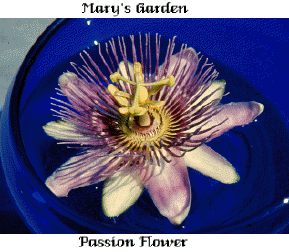
The following prayer is a traditional prayer of the members ot the Society ot Mary (Marianists). It is their custom to pray it daily as close it 3:00 p.m. as possible. For this reason they call it The Three O'Clook Prayer.
Lord, Jesus, we gather in spirit at the foot of the Cross with your Mother and the disciple whom you loved. We ask pardon of our sins which are the cause of your death. We thank you for remembering us in that hour of salvation and for giving us Mary as our Mother
Holy Virgin, take us under your protection and open us to the action of the Holy Spirit.
St. John, obtain for us the grace of taking Mary into our life as you did and of assisting her in her mission. Amen.
May the Father and the Son and the Holy Splrit be glorified in all places through the Immaculate Virgin Mary.
All About Mary includes a variety of content, much of which reflects the expertise, interpretations and opinions of the individual authors and not necessarily of the Marian Library or the University of Dayton. Please share feedback or suggestions with marianlibrary@udayton.edu.
